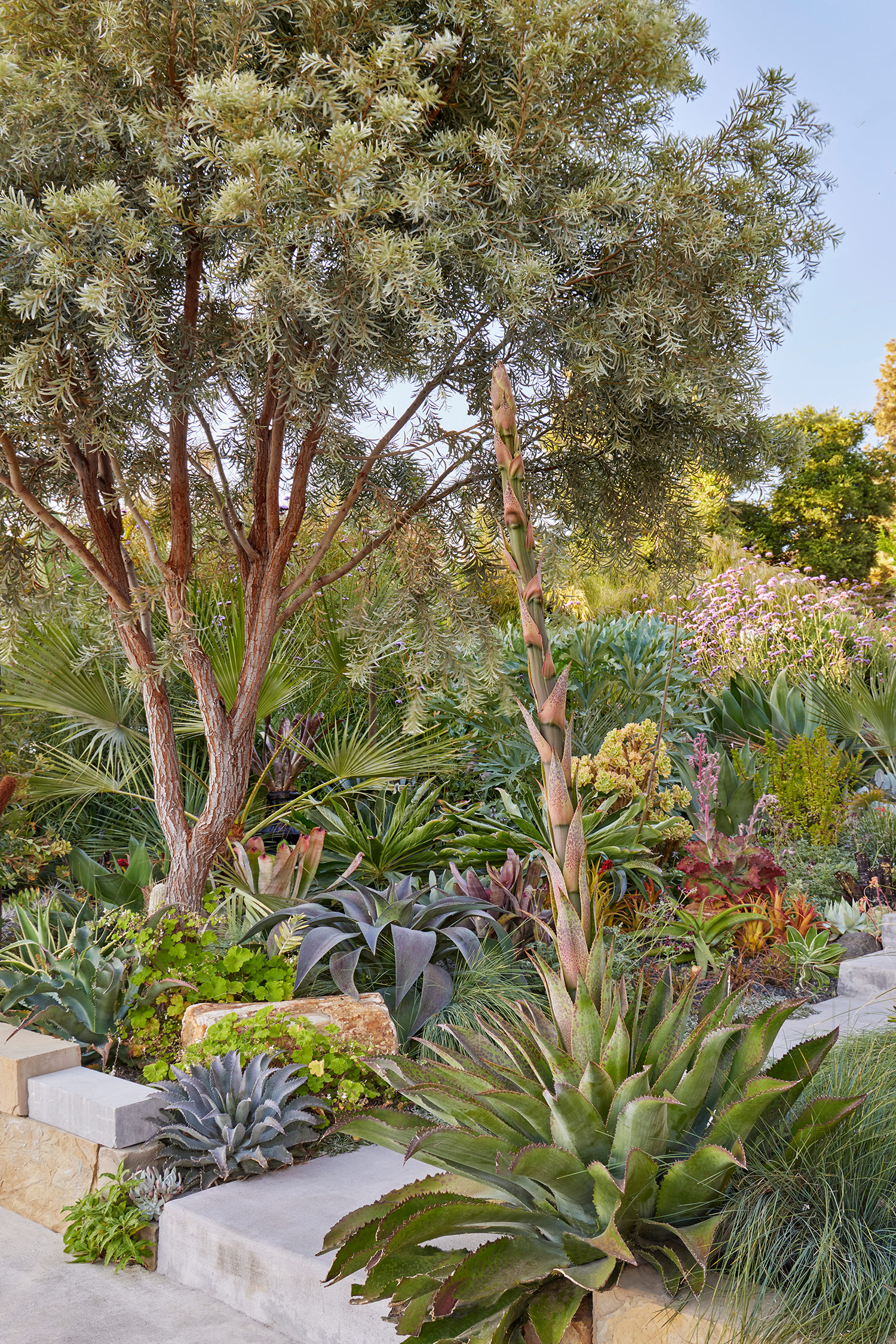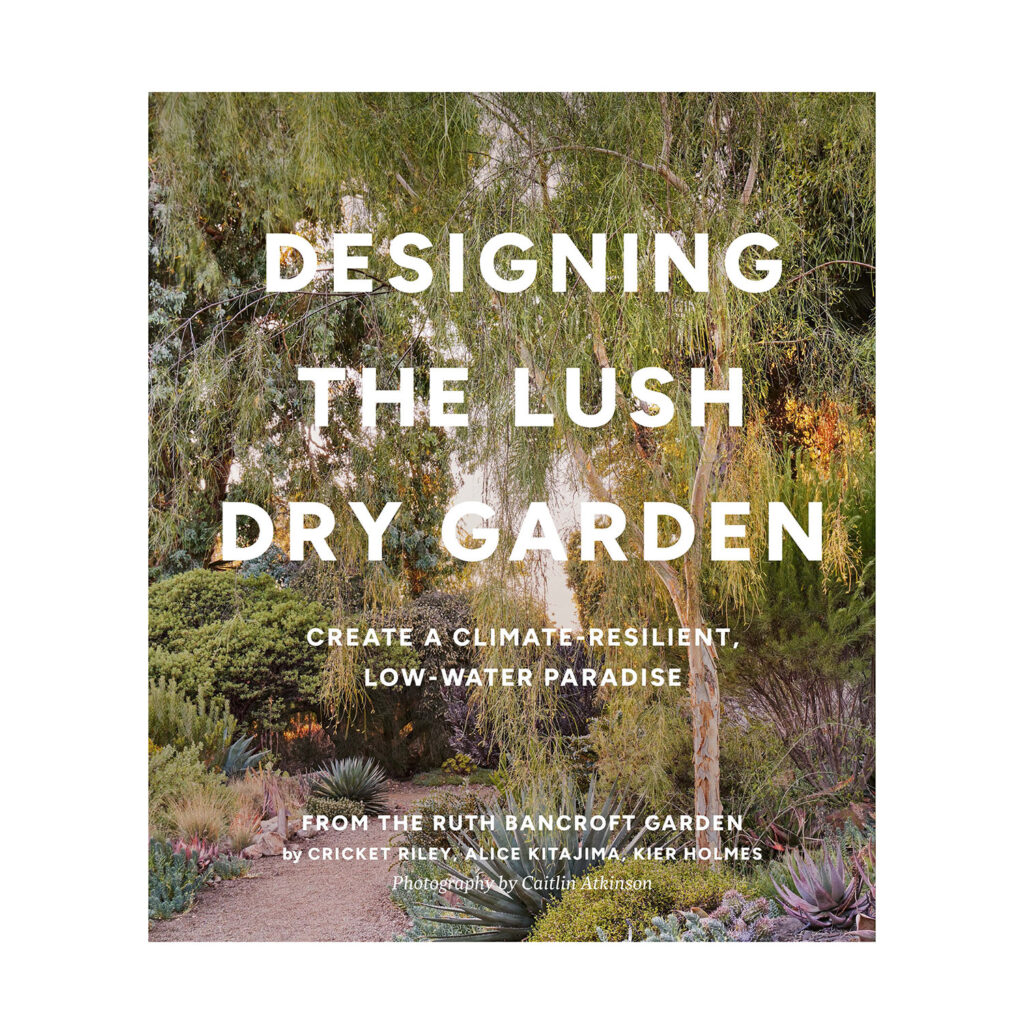Inspired by the legendary Ruth Bancroft Garden located in Walnut Creek, Designing the Lush Dry Garden reimagines what a drought-tolerant landscape can look like: layered, colorful, bold, and bursting with texture. Through smart design and thoughtful planting, authors Cricket Riley, Alice Kitajima, and Kier Holmes show that climate-resilient gardening is not only possible but also beautiful.
Whether you’re refreshing a container on your balcony or removing your lawn to create a water-wise paradise, landscape designer and author Kier Holmes shares her expert tips and inspiration for gardeners across the West, just in time for the fall planting season.
Resilience Is the New Necessary
Designing the Lush Dry Garden from The Ruth Bancroft Garden, by Cricket Riley, Alice Kitajima, and Kier Holmes. © Copyright 2025. Photographs by Caitlin Atkinson. Published by Timber Press, Portland, OR. Used by permission of the publisher. All rights reserved.
In the Western states, gardening for resilience isn’t optional—it’s essential. With rising temps, shifting rain patterns, and longer fire seasons, the landscapes that thrive are designed to adapt. But resilient doesn’t mean sparse. According to landscape designer and author Kier Holmes, climate-savvy gardens should reflect regional conditions while still offering beauty, structure, and year-round interest. That means water-wise plants, fire-smart layouts, and pollinator-friendly choices.
One of the book’s core messages is to rethink the “dry garden” stereotype. It’s not just gravel and cactus. “A dry garden can, with a judicious use of water, transform into a tapestry of color, texture, pattern, and year-round interest,” Holmes explains.
Rather than focusing on fleeting flowers or high-maintenance ornamentals, aim for sculptural silhouettes, bold foliage, and layered plantings with staying power. “Each important component is like a critical ingredient in a recipe,” Holmes says. “And each plays off each other.”
Foliage First, Flowers Later

Designing the Lush Dry Garden from The Ruth Bancroft Garden, by Cricket Riley, Alice Kitajima, and Kier Holmes. © Copyright 2025. Photographs by Caitlin Atkinson. Published by Timber Press, Portland, OR. Used by permission of the publisher. All rights reserved.
At the heart of the Ruth Bancroft Garden’s lasting appeal is a design principle that defies fleeting trends: Focus on foliage, not just flowers. While blooms come and go, it’s the bold forms, textured leaves, and striking contrasts that anchor a garden through the seasons.
Holmes, who’s been visiting the Ruth Bancroft Garden since childhood, still finds the space to be “pure magic.” She points to the visionary design lessons that home gardeners can easily adopt— especially Ruth Bancroft’s commitment to experimenting with structure over showiness. “Flowers are fantastic but fleeting,” Holmes says. “It’s smart to focus on foliage.”
Ruth Bancroft didn’t plant her now-iconic garden until age 63, and her legacy is rooted in trial and error as much as talent. She took meticulous notes, embraced slow-growing species, and had the patience to wait years—even decades—for a plant to come into its own. Her garden is a reminder that the best spaces evolve over time, shaped by curiosity, observation, and a willingness to try again.
For modern Western gardeners facing a changing climate, Ruth’s design ethos remains as relevant as ever: Be bold, embrace texture, and don’t be afraid to learn as you go.
Texture Over Turf

Designing the Lush Dry Garden from The Ruth Bancroft Garden, by Cricket Riley, Alice Kitajima, and Kier Holmes. © Copyright 2025. Photographs by Caitlin Atkinson. Published by Timber Press, Portland, OR. Used by permission of the publisher. All rights reserved.
Fall is the perfect time to rethink your garden’s bones—and that often starts with saying goodbye to the lawn. Swapping turf for climate-appropriate plantings not only saves water, it makes room for a more layered and expressive design.
Holmes recommends starting with structure. Shape the space with subtle berms, amend the soil for drainage, and introduce focal-point plants like agaves or aloes. Instead of scattering one-offs, group climate-tough plants in masses for a bold effect.
Just as important as what you plant is where you leave space. “Negative space can be created by adding hardscaping, areas of gravel, or an expanse of one type of groundcover,” she says. These pauses bring visual balance and allow key features to shine.
If your garden feels overgrown or out of step with your region’s climate, fall is your cue to edit. Remove what’s struggling, highlight what you love, and replant with resilient species that can handle seasonal extremes. The result? A garden that feels intentional, adaptive, and ready for the long haul.
The Container Glow-Up

Designing the Lush Dry Garden from The Ruth Bancroft Garden, by Cricket Riley, Alice Kitajima, and Kier Holmes. © Copyright 2025. Photographs by Caitlin Atkinson. Published by Timber Press, Portland, OR. Used by permission of the publisher. All rights reserved.
Don’t let a lack of ground space keep you from creating a lush, low-water garden. Container gardening offers a stylish, scalable way to make a big impact—especially when done with intention. According to Holmes, a well-designed container garden follows the same design principles as any great landscape: scale, proportion, and repetition.
The goal isn’t to cram a pot full of flowers but rather to build drama with contrast—think sculptural shapes, bold foliage, and unexpected color pairings. Holmes recommends focusing on form over fleeting blooms. “Focus less on flowers and more on contrasting leaf textures and shapes,” she says.
Her go-to container formula includes a “thriller” (a tall, bold focal point like Beaucarnea recurvata), a “filler” (such as Delosperma ‘Fire Spinner’), and a “spiller” that cascades over the edge—like Tradescantia pallida.
“A well-orchestrated container should be able to sustain itself through the seasons … Unless, of course, one bites the dust,” Holmes adds. In that case, simply replace it with something that shares similar light and water needs to keep the balance going strong.
Fall Plant Palette

Designing the Lush Dry Garden from The Ruth Bancroft Garden, by Cricket Riley, Alice Kitajima, and Kier Holmes. © Copyright 2025. Photographs by Caitlin Atkinson. Published by Timber Press, Portland, OR. Used by permission of the publisher. All rights reserved.
Fall is prime time for building a resilient foundation that will thrive come spring. With cooler temps and seasonal rain, it’s the perfect window to plant tough, water-wise plants.
Holmes leans into regionally appropriate choices like pollinator-friendly ceanothus, “but only where deer aren’t present,” Holmes says. She encourages mixing native textures in unexpected ways. One recent combo: a container filled with Dudleya, White Achillea, and Pacific Coast Iris.
Holmes looks for plants that can handle erratic frosts and bounce back strong. “If I plant something in the fall, I would love to see it still alive in the spring!”
Design-wise, lean into contrast and form: bold agaves with wispy grasses, or deep burgundy leaves against silver-blue succulents. A favorite pairing? Aeonium ‘Zwartkop’ alongside Senecio serpens. To keep things lush even as deciduous plants drop, Holmes recommends layering in evergreens and succulents, “so you’re not looking at too many sticks, stumps, and bare branches.”
Proof that a low-water garden doesn’t mean sacrificing style—it’s about designing with intention, curiosity, and a long view—one resilient planting at a time.
Get the Book

Designing the Lush Dry Garden from The Ruth Bancroft Garden, by Cricket Riley, Alice Kitajima, and Kier Holmes. © Copyright 2025. Photographs by Caitlin Atkinson. Published by Timber Press, Portland, OR. Used by permission of the publisher. All rights reserved.
We only recommend things we love. If you buy something through our site, we might earn a commission.



